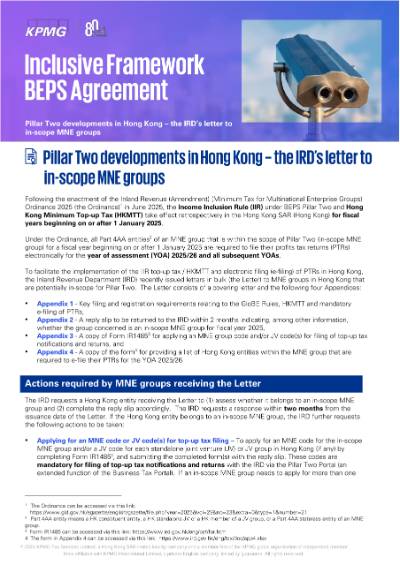Following the enactment of the Inland Revenue (Amendment) (Minimum Tax for Multinational Enterprise Groups) Ordinance 2025 (the Ordinance)1 in June 2025, the Income Inclusion Rule (IIR) under BEPS Pillar Two and Hong Kong Minimum Top-up Tax (HKMTT) take effect retrospectively in the Hong Kong SAR (Hong Kong) for fiscal years beginning on or after 1 January 2025.
Under the Ordinance, all Part 4AA entities2 of an MNE group that is within the scope of Pillar Two (in-scope MNE group) for a fiscal year beginning on or after 1 January 2025 are required to file their profits tax returns (PTRs) electronically for the year of assessment (YOA) 2025/26 and all subsequent YOAs.
To facilitate the implementation of the IIR top-up tax / HKMTT and electronic filing (e-filing) of PTRs in Hong Kong, the Inland Revenue Department (IRD) recently issued letters in bulk (the Letter) to MNE groups in Hong Kong that are potentially in-scope for Pillar Two. The Letter consists of a covering letter and the following four Appendices:
- Appendix 1 - Key filing and registration requirements relating to the GloBE Rules, HKMTT and mandatory e-filing of PTRs,
- Appendix 2 - A reply slip to be returned to the IRD within 2 months indicating, among other information, whether the group concerned is an in-scope MNE group for fiscal year 2025,
- Appendix 3 - A copy of Form IR14853 for applying an MNE group code and/or JV code(s) for filing of top-up tax notifications and returns, and
- Appendix 4 - A copy of the form4 for providing a list of Hong Kong entities within the MNE group that are required to e-file their PTRs for the YOA 2025/26.
Actions required by MNE groups receiving the Letter
The IRD requests a Hong Kong entity receiving the Letter to (1) assess whether it belongs to an in-scope MNE group and (2) complete the reply slip accordingly. The IRD requests a response within two months from the issuance date of the Letter. If the Hong Kong entity belongs to an in-scope MNE group, the IRD further requests the following actions to be taken:
- Applying for an MNE code or JV code(s) for top-up tax filing – To apply for an MNE code for the in-scope MNE group and/or a JV code for each standalone joint venture (JV) or JV group in Hong Kong (if any) by completing Form IR14853, and submitting the completed form(s) with the reply slip. These codes are mandatory for filing of top-up tax notifications and returns with the IRD via the Pillar Two Portal (an extended function of the Business Tax Portal). If an in-scope MNE group needs to apply for more than one code (e.g. one MNE code for the group and one JV code for a JV group in Hong Kong held by it), it should submit two Form IR1485s (i.e. one for applying the MNE code and the other for applying the JV code).
- Identifying Hong Kong entities subject to mandatory e-filing of PTRs – To provide a list of Hong Kong entities (including their names and respective profits tax file numbers) within the MNE group that are required to e-file their PTRs for the YOA 2025/26 by completing the form4 in Appendix 4.
In addition, the IRD strongly encourages in-scope MNE groups to assess the impact of the GloBE rules and HKMTT on them as soon as possible and share the Letter with senior accounting and/or finance officers and those responsible for international accounting and tax compliance within the groups.
KPMG observations
The Letter represents the first formal communication between the IRD and MNE groups that are potentially in-scope for Pillar Two and warrants careful and immediate attention. We recommend that in-scope MNE groups consider the following issues when responding to the Letter and as they prepare for the Pillar Two compliance as well as mandatory e-filing requirements:
- Overlap between Form IR1485 and top-up tax notification - While the primary purpose of Form IR1485 is for the IRD to issue an identification code to each in-scope MNE group, standalone JV or JV group in Hong Kong in order to facilitate the filing of top-up tax notifications and returns, there is considerable overlap between the information requested in Form IR1485 and the information required in a top-up tax notification (which are due six months after the end of the relevant fiscal year). In-scope MNE groups may therefore take this opportunity to prepare the information required for completing the top-up tax notification to avoid duplication of effort.
- Multiple codes within a business group - Each in-scope MNE group, standalone JV or JV group in Hong Kong will be issued with its own distinct MNE code or JV code. In practice, a single business group may consist of multiple constituent entities, standalone JVs and/or JV groups in Hong Kong and therefore may receive more than one corresponding code. Determining the relevant MNE groups, JVs and JV groups within a business group for Pillar Two purposes can be a complicated and time-consuming process. However, it is a critical step for determining the correct amount of top-up tax and would help reduce the risk of penalties for non-compliance in the future.
- Determining the location of a constituent entity (CE) - The determination of a CE’s location for the purposes of the GloBE rules and HKMTT may involve a complicated analysis. For example, the approach for determining the location of a dual-resident entity may vary depending on (1) the existence of a tax treaty and (2) the specific wording of that tax treaty. In addition, MNE groups in Hong Kong generally consist of companies incorporated in offshore jurisdictions (e.g. the Cayman Islands or the BVI) which may have a business presence in Hong Kong. The potential implications of such presence on their location for the GloBE rules and HKMTT purposes should therefore be carefully assessed.
- Identifying a full list of Hong Kong entities - Identifying and reporting a complete list of Hong Kong entities in Appendix 4 could be challenging, especially where different business divisions within a group only have visibility over their own entities. In-scope MNE groups should consider establishing a robust internal process to ensure all relevant entities are captured in Appendix 4 (and also for the ongoing Pillar Two compliance purposes), including those joining the groups during the year. In particular, for MNE groups with practical difficulty of providing an accurate and complete list of Hong Kong entities to the IRD by the two-month due date due to a merger, acquisition or disposal that are expected to be completed towards the end of fiscal year 2025 (or any other valid reasons), they may consider applying for a reasonable extension to provide the list to the IRD.
- Coordination for Pillar Two compliance - Compliance with the GloBE rules and HKMTT will require extensive coordination between senior management, finance and tax. The potential Pillar Two financial and compliance implications should be communicated to key stakeholders as early as possible. In-scope MNE groups should also set aside sufficient resources for the additional compliance burden and additional funding for the potential top-up tax liability.
- Mandatory e-filing of PTRs - The upcoming mandatory e-filing of PTRs represents a significant shift in the tax compliance process. Entities will be required to upload an iXBRL data file, which embeds standardised "tags" into the financial statements and tax computations, to the business tax portal for the purpose of filing the PTRs electronically. In-scope MNE groups should plan ahead and get themselves prepared for this significant change in Hong Kong tax reporting.
- Obligation to respond to the Letter - The Letter is not a notice served under section 51(4)(a) of the Inland Revenue Ordinance (IRO). Accordingly, the penalty provisions for non-compliance without reasonable excuse under section 51(4B) of the IRO are not applicable. However, we strongly recommend that in-scope MNE groups take the actions requested by the IRD in the Letter and prepare early for the Pillar Two compliance and e-filing obligations.
1 The Ordinance can be accessed via this link: https://www.gld.gov.hk/egazette/english/gazette/file.php?year=2025&vol=29&no=23&extra=0&type=1&number=21
2 Part 4AA entity means a HK constituent entity, a HK standalone JV or a HK member of a JV group, or a Part 4AA stateless entity of an MNE group.
3 Form IR1485 can be accessed via this link: https://www.ird.gov.hk/eng/paf/for.htm
4 The form in Appendix 4 can be accessed via this link: https://www.ird.gov.hk/eng/tax/doc/app4.xlsx
Connect with us
- Find office locations kpmg.findOfficeLocations
- kpmg.emailUs
- Social media @ KPMG kpmg.socialMedia


